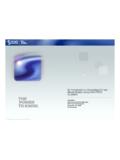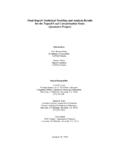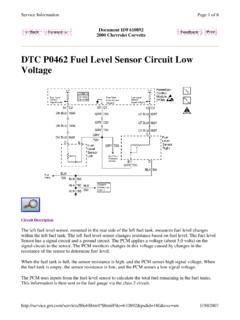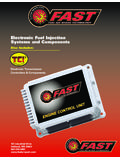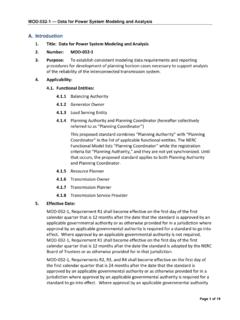Transcription of Heavy-Duty Diesel Vehicle Fuel Consumption Modeling …
1 Paper Offer # : 05CV-3. Heavy-Duty Diesel Vehicle fuel Consumption Modeling Based on Road Load and Power Train Parameters , , NVFEL, Environmental Protection Agency, Ann Arbor, MI. UCR Statistical Consulting Collaoratory, Riverside, CA. , Center for Environmental Research and Technology, Riverside, CA. Copyright 2005 SAE International ABSTRACT Currently, the US EPA is basing its emissions Modeling 16. efforts (MOVES) on correlations of emissions with VSP. The EPA is developing a new generation emissions ( , tractive power divided by Vehicle mass). 14,15. inventory model, MOVES (Motor Vehicle Emissions supplemented with a model (PERE) based on the Simulator). The first version of the model outputs fuel second more complete treatment of Vehicle power Consumption based on available modal data.
2 However, Consumption . In this work, the road load, engine and due to the limited Heavy-Duty Vehicle data, MOVES rates transmission parameters for Diesel transit buses and need to be supplemented with rates determined with the Heavy-Duty Diesel trucks which will be used in PERE are Physical Emission Rate Estimator (PERE). PERE described. The data used to determine the parameters 17-21. combines Vehicle tractive power together with Vehicle were from on-road Heavy-Duty Diesel truck (University powertrain parameters specific to the class of Vehicle ; of Riverside's CE-CERT) and USEPA sponsored city 22. the Vehicle weight, shape, engine type, and transmission. transit bus measurements. Engine efficiency for non- Analysis of in-use data for Heavy-Duty Diesel tractor- road engines from USEPA sponsored dynamometer 23, 24.
3 Trailer vehicles, city transit Diesel buses, and based measurements have also been determined. dynamometer non-road Diesel engines has enabled a Comparison of results for model calculated fuel determination of Diesel engine efficiency and friction and Consumption and CO2 emissions with measured on-road transmission shift schedules for these engines and values are given. vehicles. These model parameters and a comparison of the model results to measured fuel Consumption and MODEL DESCRIPTION. CO2 emissions are presented. As mentioned earlier, equating Vehicle power to Vehicle INTRODUCTION fuel Consumption and emissions is central to the workings of the internal combustion engine. All major Vehicle fuel Consumption is directly related to the Vehicle components of the Vehicle which contribute to the power Consumption which has an implicit time Consumption of power from fuel ignition to rolling tires dependence realized in the speed-time trace or cycle have been studied and continue to be studied.
4 However, under which the Vehicle has been driven. However, only efforts to include these components in emissions until recently with the availability of time-resolved speed, Modeling have only been taken in earnest when time- emissions and fuel Consumption measurements has this resolved emissions data have become available. This relationship been employed to develop Vehicle emissions work is based on the more complete treatment of Vehicle 1-15 power Consumption which includes engine friction and models which more accurately estimate emissions from vehicles on any driving cycle. There are two efficiency, Vehicle transmission, and Vehicle road load 1-6 parameters. These parameters are employed in this approaches being used.
5 One uses the correlation between Vehicle tractive power or Vehicle specific power work to estimate fuel Consumption and CO2 emissions 7-15 from Heavy-Duty Diesel trucks and Diesel transit buses. (VSP) with emissions and the second more complete approach considers all of the major power Consumption Since this work is mainly concerned with parameter components, , Vehicle tractive power, engine friction development for Heavy-Duty trucks and transit buses and and efficiency and transmission efficiency and shift because the Diesel version of this model has been 10. schedule. described in detail in earlier work , only a schematic description of the model and its parameters will be given here. There are four major components of this model, (i).
6 Engine friction and efficiency, (ii.) engine maximum where is the engine friction. Explicitly, the engine friction 25,26. torque map, (iii.) Vehicle transmission, and (iv.) Vehicle can be parameterized in terms of the engine speed, 2. road load parameters. All of these components, but the N, and the mean piston speed, Sp , Vehicle transmission parameters, can be derived from a 7-15. relationship for fuel Consumption , FR, k = k 0 + k1 N + k 2 S p2. ( N V d / 2000 ) In this work the engine friction is only determined as a FR = ( fmep + bmep ). LHV i function of engine speed. 1 k N V 1 TRANMISSION PARAMETERS. = + P k =. i , d FR fmep LHV 2000 i The heavy truck and transit bus transmission Modeling is more simply stated as a mapping between time-resolved engine and Vehicle speed (shift schedules).
7 The mapping where N is engine speed in revolutions per second, Vd is includes ratios of engine speed to Vehicle speed for each the engine displacement in liters, LHV is the fuel lower gear and either a single value of the engine maximum heating value in kJ/kg, i in the indicated engine torque (or power) or the engine's maximum torque (or efficiency, k is engine friction in kPa, bmep is the brake power) dependence on engine speed. In this work the mean effective pressure in kPa, fmep is the friction mean shift schedules were determined from on-road Vehicle effective pressure in kPa, P is the sum of the Vehicle speed and engine speed measurements. To allow for tractive power and accessory power both in kW.
8 Downshifting, a maximum engine torque map was developed from a number of manufacturer specified ROAD LOAD PARAMETERS maximum torque maps. It can be scaled according to the Vehicle 's rated engine maximum torque (or power). (The Vehicle road load parameters and transmission maximum engine torque maps allow for a check on efficiency, t, are contained in the sum of the tractive engine power in a given gear. If the Vehicle power is load, Ptrac, and accessory power, Pacc, term, P, larger than the maximum power, the gear is lowered.). DATA. Ptrac P= + Pacc t 17-21 22. On-road heavy Diesel truck and transit bus based measurements, non-road Diesel engine dynamometer Af CD air 3. (. Ptrac = Mg v CR0 + v 2CR1 )+ Mg CR2 + v + Mv (a + g sin ) based measurements 23,24.
9 , and literature searches were 2 . used to determine model parameters. The on-road data 22. where the terms in the tractive power equation are was from an EPA study of Diesel transit buses and a 17-21. defined at the end this document. Tire rolling loss terms, CE-CERT study of loaded Heavy-Duty Diesel tractor CR0, CR1, and CR2, and aerodynamic loss terms AfCD air/2 trailers. Table 1. is a short list of the vehicles and determined in this work are all contained in the engines in each study along with technical specifications expression for tractive power, Ptrac. regarding Vehicle mass, engine size, More detailed information about the vehicles and engines can be found ENGINE FRICTION AND EFFICIENCY in the references listed.
10 22. Heavy-Duty Diesel engine friction and efficiency In the EPA study 15 city transit buses were driven parameters are determined using a Willans curve without passengers along established Ann Arbor Transit 25. methodology ( , Heywood ) based on the fuel rate Authority (AATA) bus routes. Pollutant (HC, CO, CO2, equation and the following definition of fuel mean and NOx) emissions, Vehicle speed, engine speed, fuel 7-15. effective pressure, fuel mep . The fuel mean effective Consumption , engine load, and other engine parameters pressure (total fuel consumed in units of pressure) can were recorded from the Vehicle 's electronic control be related to the indicated mean effective which is the module (ECM), a global positioning system (GPS), and a sum of the bmep and the engine friction 7-15.
